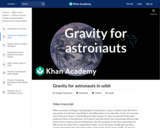
Why do astronauts appear weightless despite being near the Earth? Created by Sal Khan.
- Subject:
- Force/Motion/Energy
- Science
- Material Type:
- Lesson
- Provider:
- Khan Academy
- Provider Set:
- Khan Academy
- Author:
- Sal Khan
- Date Added:
- 07/07/2022

Why do astronauts appear weightless despite being near the Earth? Created by Sal Khan.

MWM President Phyllis Wilson sits down with Lt. Gen. Susan Helms, USAF (Ret.). Not only did Helms serve in the U.S. Air Force, but she was also a NASA astronaut. She has been to space five times for a total of 211 days. She graduated from the Air Force Academy in 1980 and became a weapons separation engineer and test pilot before joining NASA. She returned to the Air Force in 2002 to work at the HQ USAF Space Command. Helms also served as the 45th Space Wing Commander. While with NASA, she flew aboard the Space Shuttles Endeavor, Discovery, Columbia and Atlantis, and served aboard the International Space Station. She held the world record for longest space walk at 8 hours and 56 minutes.Staying true to our mission, HERstory programming explores the lived experiences of women veterans throughout American history. HERstory is a program where women veterans share their stories in video chats with President Wilson.We are the leading memorial and education center honoring women’s contributions to the service of our nation. As the only historical repository documenting all military women’s service, we educate and inspire through innovative and interactive exhibitions, our world-class collections, and engaging programs and events for all generations. We honor the commitment, contributions and experiences of every woman who serves in, or with, the Armed Forces.

Jasmin Moghbeli is a Marine Corps aviator and an astronaut. As a 2020 graduate of NASA’s Astronaut Candidate Training Program, she is eligible to be the first woman on the moon as part of the Artemis Program. The HERstory Spotlight Series takes a look at stories from both our Register, an interactive online database of military women, and our world class collection. The Military Women’s Memorial, a 501(c)(3) nonprofit organization, is the only historical repository documenting all military women’s service. It is located at the ceremonial entrance to Arlington National Cemetery and features an education center, interactive exhibitions, a world-class collection of military women’s stories, and engaging programs and events for all generations. Find out more about us at www.womensmemorial.org.

During the height of the Space Race, Air Force Col. Pearl E. Tucker led a course in aerospace nursing. To understand spaceflight and to be prepared to render medical aid, the aerospace nurses underwent much of the same training as astronauts. The nurses paved the way for women to have increasingly integral roles in space exploration in later years.The Military Women’s Memorial, a 501(c)(3) nonprofit organization, is the only historical repository documenting all military women’s service. It is located at the ceremonial entrance to Arlington National Cemetery and features an education center, interactive exhibitions, a world-class collection of military women’s stories, and engaging programs and events for all generations. Find out more about us at www.womensmemorial.org.
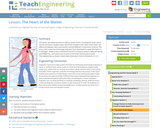
This lesson describes how the circulatory system works, including the heart, blood vessels and blood. Students learn about the chambers and valves of the heart, the difference between veins and arteries, and the different components of blood. This lesson also covers the technology engineers have developed to repair the heart if it is damaged. Students also understand how the circulatory system is affected during spaceflight (e.g., astronauts lose muscle in their heart during space travel).

Students apply their mathematics and team building skills to explore the concept of rocketry. They learn about design issues faced by aerospace engineers when trying to launch rocketships or satellites in order to land them safely in the ocean, for example. Students learn the value of designing within constraints while brainstorming a rocketry system using provided materials and a specified project budget. Throughout the design process, teamwork is emphasized since the most successful launches occur when groups work effectively to generate creative ideas and solutions to the rocket challenge.
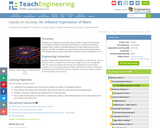
Students use scaling from real-world data to obtain an idea of the immense size of Mars in relation to the Earth and the Moon, as well as the distances between them. Students calculate dimensions of the scaled versions of the planets, and then use balloons to represent their relative sizes and locations.
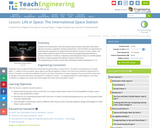
Students are introduced to the International Space Station (ISS) with information about its structure, operation and key experiments. The ISS itself is an experiment in international cooperation to explore the potential for humans to live in space. The space station features state-of-the-art science and engineering laboratories to conduct research in medicine, materials and fundamental science to benefit people on Earth as well as people who will live in space in the future.
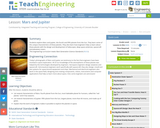
Students explore Mars and Jupiter, the fourth and fifth planets from the Sun. They learn some of the unique characteristics of these planets. They also learn how engineers help us learn about these planets with the design and development of telescopes, deep space antennas, spacecraft and planetary rovers.
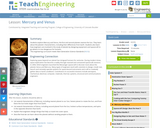
Students explore Mercury and Venus, the first and second planets nearest the Sun. They learn about the planets' characteristics, including their differences from Earth. Students also learn how engineers are involved in the study of planets by designing equipment and spacecraft to go where it is too dangerous for humans.
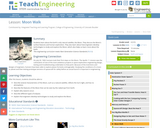
Students learn about the Earth's only natural satellite, the Moon. They discuss the Moon's surface features and human exploration. They also learn about how engineers develop technologies to study and explore the Moon, which also helps us learn more about the Earth.
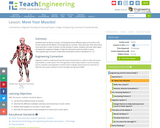
This lesson covers the topic of muscles. Students learn about the three different types of muscles in the human body and the effects of microgravity on muscles. Students also learn how astronauts need to exercise in order to lessen muscle atrophy in space. Students discover what types of equipment engineers design to help the astronauts exercise while in space.

Students are introduced to the futuristic concept of the moon as a place people can inhabit. They brainstorm what people would need to live on the moon and then design a fantastic Moon colony and decide how to power it. Students use the engineering design process, which includes researching various types of energy sources and evaluating which would be best for their moon colonies.

Video description: Join NASA to learn more about solar eclipses, especially the awe-inspiring phenomenon of total eclipses. Find out about the unique geometry and the distances and sizes of the sun and moon as seen from Earth that allow us to witness the sun's corona or actually be in the path of totality. Video length: 7:15. NASA eClipsTM is a suite of online student-centered, standards-based resources that support instruction by increasing STEM literacy in formal and nonformal settings. These free digital and downloadable resources inform and engage students through NASA-inspired, real-world connections.NASA eClips Launchpad videos focus on NASA innovations and the technology that take us into the future. These segments support project-based and problem-based learning experiences in science, mathematics, and career and technical education classrooms.

Video Description: Learn about the global cooperation to build the International Space Station, or ISS. Use a simple scale model to demonstrate the amazing mathematical relationship between the Earth and moon and see how the low-Earth orbit of ISS compares. Video Length: 5:57.NASA eClipsTM is a suite of online student-centered, standards-based resources that support instruction by increasing STEM literacy in formal and nonformal settings. These free digital and downloadable resources inform and engage students through NASA-inspired, real-world connections.NASA eClips Our World videos (grades 3-5) help students understand the differences between science (the natural world) and engineering (the designed world). These video segments supplement elementary learning objectives not only in science, technology, engineering and mathematics, but also in reading, writing, visual and performing arts.

Video Description: Satellites are expensive to build and expensive to get into space. With all the changes in technology, is there a way to make satellites smaller? Find out just what NASA can pack into a 1U CubeSat, a satellite small enough to fit in your hand. Video Description: 3:24.NASA eClipsTM is a suite of online student-centered, standards-based resources that support instruction by increasing STEM literacy in formal and nonformal settings. These free digital and downloadable resources inform and engage students through NASA-inspired, real-world connections.NASA eClips Real World segments (grades 6-8) connect classroom mathematics to 21st Century careers and innovations. They are designed for students to develop an appreciation for mathematics through real-world problem solving.

Video Description: CubeSats are changing the way we collect information. They may be small, but these little satellites are helping us answer big questions. And using a swarm of CubeSats can give us simultaneous measurements without repeatedly sending commands to the satellite to tell it what to do.Video Length: 2:21.NASA eClipsTM is a suite of online student-centered, standards-based resources that support instruction by increasing STEM literacy in formal and nonformal settings. These free digital and downloadable resources inform and engage students through NASA-inspired, real-world connections.NASA eClips Real World segments (grades 6-8) connect classroom mathematics to 21st Century careers and innovations. They are designed for students to develop an appreciation for mathematics through real-world problem solving.

Video Description: Have you ever wondered what living in space would do to your body? In this Real World video, learn how NASA scientists study cells on Earth to learn how to protect astronauts from radiation during space flights. Dr. Egle Cekanaviciute describes changes in cells and cell organelles. She also compares quantitative and qualitative data and demonstrates how to calculate the percentage of mutated cells. Video length: 6:35.NASA eClipsTM is a suite of online student-centered, standards-based resources that support instruction by increasing STEM literacy in formal and nonformal settings. These free digital and downloadable resources inform and engage students through NASA-inspired, real-world connections.NASA eClips Real World segments (grades 6-8) connect classroom mathematics to 21st Century careers and innovations. They are designed for students to develop an appreciation for mathematics through real-world problem solving.

This lesson describes the function and components of the human nervous system. It helps students understand the purpose of our brain, spinal cord, nerves and the five senses. How the nervous system is affected during spaceflight is also discussed in this lesson.

Normally we find things using landmark navigation. When you move to a new place, it may take you awhile to explore the new streets and buildings, but eventually you recognize enough landmarks and remember where they are in relation to each other. However, another accurate method for locating places and things is using grids and coordinates. In this activity, students will come up with their own system of a grid and coordinates for their classroom and understand why it is important to have one common method of map-making.